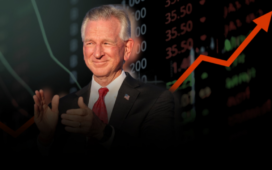getty
Six months in the stock market is a blip. The first half of 2025 promises to be different, due to the beginning of Donald J. Trump’s second term as president and the many changes he’s promised—looser regulations, mass deportations and tariffs. Then, there’s the Federal Reserve, whose announcement December 18, 2024 tanked the market; more Fed announcements are coming in 2025. In this article, I discuss what may be ahead with economic indicators, sectors, global market influences and market volatility.
Why It’s Important To Analyze The First Six Months
Looking at the first half year is a way of taking a measure of where the country and you as an investor might be headed.
January through June of any year is when economic trends, policy changes and corporate strategies begin to reveal themselves and it’s also when many investors adopt a clean slate with renewed discipline. “It’s during this time that investors should lay the foundation for the rest of the year by planning accordingly,” Rob Edwards of Edwards Asset Management, told me.
Robin Giles, CFP at Apex Wealth Management in Katy, Texas, told me that Trump could bring on new economic policies and changes to the tax code. “The first six months will be a good indication of what policies are likely to be put in place versus those that turn out to be campaign promises and political posturing.”
Much more than breaking news, our diverse reporting digs deeper with unparalleled insights that empower you to make better informed decisions. Become a Forbes member and get unlimited access to cutting-edge strategies, actionable insights, and updated analysis from our network of leading finance experts. Unlock Premium Access — Free For 25 Days.
Key Economic Indicators To Watch In 2025
One important economic touchstone is Inflation. On December 18, Fed Chair Jerome Powell said the Fed is trying to tamp down inflation with fewer interest rate cuts in 2025 than originally planned. Inflation and employment rates, tied to consumer spending, are also key indicators.
Inflation Trends And Fed Policy
“Interest rates are like gravity. If they are higher, they pull down economic growth (via higher borrowing costs) and equity valuations,” Jason Ware, chief investment officer of Albion Financial Group in Salt Lake City, told me. In such an environment, the competition for dollars is tight when allocating assets.That’s because higher yields are stronger competitors against stock volatility and risks, he added. “In a nutshell, those are the key reasons why interest rates and, thus, Fed policy matter,” said Ware.
Powell surprised the market in December by saying the Fed would have two rate cuts, not four, in 2025 because inflation is hanging on and the agency wants to corral it. That sent the market tumbling down; the Dow Jones Industrial Average plummeted by more than 1,100 points. Powell originally said the Fed wouldn’t cut the interest rate until inflation fell to 2%. It didn’t, and the Fed cut the rate anyway, twice. The current inflation rate is about 2.9%.
Ware believes that inflation is “largely yesterday’s problem.” He added that there are possible positive risks to inflation, but he doesn’t think it will hurt the stock market because of the new president’s line of thinking: “Trump cares too much about what markets say about how good a job he’s doing,” he said.
Stephen Wu, founder and managing partner of Carthage Capital Management, told me that while inflation seems to be easing, core inflation is “sticky,” which could make margins tight for some companies.
Employment Rates And Consumer Spending Trends
Two factors that point to a robust economy are healthy employment and consumer confidence. As a result, when Americans are employed and have confidence in the economy, they spend more and the economy grows.
As of the third week of January 2025, the unemployment rate was at 4.1%, according to the U.S. Bureau of Labor Statistics. The research organization the Conference Board reported that consumer confidence rose 2.1 points in November to 111.7 from the October number of 109.6. Other measures from the Conference Board are the Present Situation Index, based on current business and labor market conditions, which increased in November by 4.8 points, and the Expectations Index, based on consumers’ short-term outlook for income, business and labor market conditions. It “ticked up 0.4 points to 92.3, well above the threshold of 80 that usually signals a recession ahead,” reported the organization.
Sector Performance Projections
Most financial advisors steer their clients toward maintaining a balanced portfolio that is “market-neutral,” as Stephen Wu told me. The idea is that such a portfolio can weather an up or a down market.
Others, including many types of financial services professionals, have favorites. Here are some from select professionals who spoke with me about sectors.
Scott Helfstein, head of investment strategy at Global X, a provider of ETFs, said that manufacturing, a $7 trillion part of the economy, is set for recovery after a “prolonged contraction,” thanks to expected tariff policies under Trump and increased business activity that may trigger growth. Another area he pegged for growth are small- and mid-cap companies—and that’s an area that others are touting as ripe for solid investment. “While capital expenditure slowed in 2024, deregulation and increased business activity could encourage expansion and investment,” said Helfstein. With wars waging, countries are building up arms and that’s good news for new defense technologies, added Helfstein. “Advances in defense tech—spanning automation, autonomous drones and cybersecurity—are reshaping the sector. Increasing government investment in national security and technology innovation is bolstering long-term growth potential,” he added.
Marta Norton, chief investment strategist at Empower Investments, told me that “from a valuation perspective, few opportunities persist in the U.S. market, though some areas, like financial services and technology, are more expensive than others.” She’s in the small-cap camp, too. Said Norton, “Small caps do appear to offer a real valuation opportunity vis-à-vis large caps. By adding marginally more small-cap exposure to a portfolio at the expense of mega tech, investors will be able to combat overvaluation concerns along with concentration risk that persists in the broader market.”
Chris Hyzy, CIO for Merrill and Bank of America Private Bank. painted in broad strokes. “We continue to believe that sector performance will be mixed in 2025 as growth re-accelerates. We favor the cyclicals in general, such as financials and industrials. We believe technology holds some of its leadership position as generative AI broadens out.”
Discover more in-depth insights, entrepreneurial advice and winning strategies that can propel your journey forward and save you from making costly mistakes. Elevate your journey by becoming a Forbes member. Unlock Premium Access — Free For 25 Days.
Global Market Influences
Because it is a small world after all, the global market is your market.
“Global events can have a dramatic effect across the world and can impact your portfolio,” said Robin Giles. “One major catastrophe, war or political fight can change what countries we do business with and what access we have to goods.”
Stephen Wu noted that geopolitical risks, such as the war in Ukraine or potential tensions in Taiwan “could ripple across industries like energy or manufacturing, adding more uncertainty.”
Jason Ware takes a contrarian view, albeit with conditions. Through all of that turbulence, he sees opportunities for buying. “Unless the geopolitical event actually harms the economy, corporate earnings, structurally sends oil and commodity prices higher (inflationary), or alters the state of the world as we know it, investors should ignore geopolitics and invest for the long-term.”
Market Volatility
Many financial professionals see January through June 2025 as a time of ups and downs. “The first six months of 2025 are shaping up to be pretty volatile,” said Stephen Wu. ”The heavy concentration of tech in the S&P 500 means that even small hiccups in AI adoption or profitability could lead to big swings in the market.”
After the up market of 2024, it’s not unexpected to experience volatility ”as complacency is tested, some trades unwind, market rotations occur and policy uncertainty–both at the Fed and with the new administration–create periods of uncertainty,” said Ware.
How To Prepare Your Investments For the First Six Months In 2025
Is it business as usual as you prepare your portfolio for 2025?
“This is a time for caution and balance. A market-neutral strategy—one that performs whether the market goes up or down—is a good approach,” Wu told me. That means diversifying into sectors that are less impacted by global or tech-specific risks, like healthcare or utilities, and in tech, no “speculative plays, but companies that already have clear paths to profitability.”
In many quarters, “buy low, sell high” is the holy grail of investing, but Angela Palacios, partner at the Center for Financial Planning in Southfield, Michigan, has another idea. She says “yes!” to investing now. She acknowledged that it may sound counterintuitive to invest when the market is scaling sky-high. However, she has studied the market for some time and noticed that today’s conditions “show forward returns when the markets are making new highs.”
So your answer to how to prepare your investments to get you from January to June 2025 is personal with a big dose of study, consultations and common sense. Answer these questions–what’s best for you and your family, what does your FA recommend and what do you think is the right path to take–and you’ll more than likely get to the right place for you and your portfolio.
Bottom Line
The year 2025 brings with it excitement, uncertainty and, like every year, a time to reset. The first six months provide both a taste of what’s to come and a time to try your best to make your portfolio “market-neutral,” which performs well whether the market is up or down, in spite of machinations of a new Trump administration, a Fed pullback and roiling world events.
Whether it’s mastering cutting-edge strategies, uncovering actionable investment opportunities from influential leaders, or breaking down complex topics, our in-depth journalism has you covered. Become a Forbes member and gain unlimited access to bold ideas shaking up industries, expert guides and practical investment advice that keeps you ahead of the market. Unlock Premium Access — Free For 25 Days.





